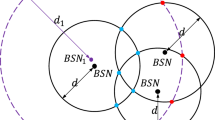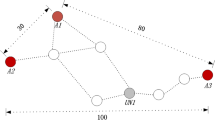Abstract
WSNs (Wireless Sensor Networks) are critical components of the Internet of Things (IoT). With the internationalization of the IoT and the widespread use of apps, it is crucial to increase WSNs localization algorithms' accuracy and their flexibility to dynamic and changing surroundings. To this end, it is proposed in this article a wireless sensor network location algorithm based on Manhattan distance (MDV-Hop) to solve many existing problems encountered in the wireless sensor network location algorithm. The MDV-Hop localization algorithm improves over present algorithms regarding frequency hopping, length, and least-squares of nodes to enhance the WSNs nodes' location accuracy and algorithm's adaptability in multi-variable environments. Manhattan distance has the characteristics of the sum of the projection distance of the line segment between two points on the coordinate axis in Euclidean space. The Manhattan distance measurement method is combined with Euclidean distance to determine the second minimum frequency hopping between beacon nodes, which substantially increases the DV-Hop algorithm's localization performance. On this foundation, the multi-objective genetics (NSGA-II) algorithm is employed to refine the outcomes of the least-squares approach to increase the suggested algorithm's localization accuracy, as it succeeds the simplicity and flexibility of the original DV-Hop method. Extensive simulations are performed in network scenarios with sparse and unevenly distributed anisotropic sensor nodes, and experimental results show that the MDV-Hop method outperforms the current WSNs node localization techniques in terms of performance and precision.










Similar content being viewed by others
References
Mustafa, M., Ali, B. M., & Hashim, S., et al. (2016). Work in progress: A proposal for a hotspot metric to extend the lifetime in wireless sensor network. In: 2016 international conference on advances in computing, communications and informatics (ICACCI). IEEE, 2016.
Yang, X., Zhou, Q., Wang, J., et al. (2020). An energy-efficient dynamic decision model for wireless multi-sensor network. The Journal of Supercomputing, 76, 1585–1603.
Di Martino, B., Li, K., Yang, L. T., & Esposito, A. (2018). Internet of everything: Technology. Springer.
Liu, G., Qian, Z., & Wang, X. (2019). An improved DV-Hop localization algorithm based on hop distances correction. Communications
Li, K., Jiang, H., & Zomaya, A. Y. (2017). Big data management and processing. Boca Raton: CRC Press.
Li, T., et al. (2019). A WSN positioning algorithm based on 3D discrete chaotic mapping. EURASIP Journal on Wireless Communications and Networking, 2019, 1–13.
Hadir, A., Zine-Dine, K., Bakhouya, M., et al. (2018). Localization algorithms for mobile nodes for three-dimensional WSNs. In: The 2018 6th international conference on wireless networks and mobile communications (WINCOM), 2018.
Yu, X., & Hu, M. (2019). Hop-count quantization ranging and hybrid cuckoo search optimized for DV-HOP in WSNs. Wireless Personal Communications, 108(4), 2031–2046.
Xu, Z., et al. (2021). A time-sensitive token-based anonymous authentication and dynamic group key agreement scheme for industry 50. IEEE Transactions on Industrial Informatics. https://doi.org/10.1109/TII.2021.3129631
Hao, Z., Qu, N., Dang, X., et al. (2019). RSS-based coverage deployment method under probability model in 3D-WSN. IEEE Access, 99, 1.
Liang, W., et al. (2022). Spatial-temporal aware inductive graph neural network for C-ITS data recovery. IEEE Transactions on Intelligent Transportation Systems. https://doi.org/10.1109/TITS.2022.3156266
Sharma, G., & Kumar, A. (2017). Improved range-free localization for three-dimensional wireless sensor networks using genetic algorithm. Computers & Electrical Engineering
Han, D., Zhu, Y., Li, D., et al. (2021). A Blockchain-based auditable access control system for private data in service-centric IoT environments. IEEE Transactions on Industrial Informatics. https://doi.org/10.1109/TII.2021.3114621
Huang, Y., & Zhang, L. (2019). Weighted DV-hop localization algorithm for wireless sensor network based on differential evolution algorithm. In: 2019 IEEE 2nd international conference on information and computer technologies (ICICT) (2019), pp 14–18.
Liang, W., et al. (2017). A distributed data secure transmission scheme in wireless sensor network. International Journal of Distributed Sensor Networks. https://doi.org/10.1177/1550147717705552
Chen, J., Wang, S., Ouyang, M., et al. (2019). Iterative positioning algorithm for indoor node based on distance correction in WSNs. Sensors, 19(22), 4871.
Xue, D. (2019). Research of localization algorithm for wireless sensor network based on DV-Hop. EURASIP Journal on Wireless Communications and Networking, 218, 1–8.
S. Xie et al. (2018) A novel bidirectional RFID identity authentication protocol. In: 2018 IEEE SmartWorld, ubiquitous intelligence & computing, advanced & trusted computing, scalable computing & communications, cloud & big data computing, internet of people and smart city innovations. doi: https://doi.org/10.1109/SmartWorld.2018.00085
Li, T., et al. (2020). Research on DV-Hop improved algorithm based on dual communication radius. EURASIP Journal on Wireless Communications and Networking, 2020, 1–10.
Cui, L., Xu, C., Li, G., et al. (2018). A high accurate localization algorithm with DV-hop and differential evolution for wireless sensor network. Applied Soft Computing, 68, 39–52.
Fang, W., Xu, H., & Yang, G. (2019). Improved DV-hop algorithm based on minimum hops correction and revaluate hop distance. In: 2019 5th international conference on information management (ICIM).
Huang, X., Han, D., Cui, M., et al. (2021). Three-dimensional localization algorithm based on improved A and DV-Hop algorithms in wireless sensor network*. Sensors, 21(2), 448.
Chen, J., Zhang, W., Liu, Z., et al. (2020). CWDV-Hop: A hybrid localization algorithm with distance-weight DV-Hop and CSO for wireless sensor networks. IEEE Access, 99, 1.
Messous, S., & Liouane, H. (2020). Online sequential DV-Hop localization algorithm for wireless sensor networks. Mobile Information Systems, 2020, 8195309-1-8195309–14.
Goyat, R., Rai, M. K., Kumar, G., et al. (2019). Energy efficient range-free localization algorithm for wireless sensor networks. Sensors, 19(16), 3603.
Shi, Q., Xu, Q., & Zhang, J. (2019). An improved DV-Hop scheme based on path matching and particle swarm optimization algorithm. Wireless Personal Communications, 104, 1301–1320.
Kaur, A., et al. (2018). Nature inspired algorithm-based improved variants of DV-hop algorithm for randomly deployed 2D and 3D wireless sensor networks. Wireless Personal Communications, 101, 567–582.
Phoemphon, S., So-In, C., & Leelathakul, N. (2018). Optimized hop angle relativity for DV-hop localization in wireless sensor networks. IEEE Access, 6, 78149–78172.
Shahzad, F., Sheltami, T., et al. (2017). DV-maxHop: A fast and accurate range-free localization algorithm for anisotropic wireless networks. IEEE Transactions on Mobile Computing, 16, 2494–2505.
Gao, G., & Lei, L. (2010). An improved node localization algorithm based on DV-HOP in WSN. In: International conference on advanced computer control. IEEE, 2010
Li, D., Han, D., Zhang, X., et al. (2019). Panoramic image mosaic technology based on SIFT algorithm in power monitoring. In: 2019 6th international conference on systems and informatics (ICSAI), 2019, pp. 1329–1333
Singh, S. P., & Sharma, S. C. (2018). A PSO-based improved localization algorithm for wireless sensor network. Wireless Personal Communications, 98, 487–503.
Song, L., Zhao, L., & Ye, J. (2019). DV-Hop node location algorithm based on GSO in wireless sensor networks. Journal of Sensors, 2019, 9.
Han, D., Yu, Y., Li, K.-C., et al. (2020). Enhancing the sensor node localization algorithm based on improved DV-Hop and DE algorithms in wireless sensor networks. Sensors, 20(2), 343.
Omar, C., Ghulam, M. B., & Roobaea, A. (2018). A hybrid DV-Hop algorithm using RSSI for localization in large-scale wireless sensor networks. Sensors, 18(5), 1469.
Kanwar, V., & Kumar, A. (2020). DV-Hop based localization methods for additionally deployed nodes in wireless sensor network using genetic algorithm. Journal of Ambient Intelligence and Humanized Computing, 11(8), 5513–5531.
Ye, Q., Bie, H., et al. (2021). EdgeLoc: A robust and real-time localization system towards heterogeneous IoT devices. IEEE Internet of Things Journal. https://doi.org/10.1109/JIOT.2021.3101368
Acknowledgements
This work is supported by the National Natural Science Foundation of China under Grants Nos. 61873160 and 61672338, National Key R&D Program of China under No. 2021YFC2801000, Natural Science Foundation of Shanghai under Grant No. 21ZR1426500.
Funding
The authors have not disclosed any funding.
Author information
Authors and Affiliations
Corresponding author
Ethics declarations
Conflict of interest
The authors declare that they have no known competing financial interests or personal relationships that could have appeared to influence the work reported in this paper.
Additional information
Publisher's Note
Springer Nature remains neutral with regard to jurisdictional claims in published maps and institutional affiliations.
Rights and permissions
Springer Nature or its licensor holds exclusive rights to this article under a publishing agreement with the author(s) or other rightsholder(s); author self-archiving of the accepted manuscript version of this article is solely governed by the terms of such publishing agreement and applicable law.
About this article
Cite this article
Huang, X., Han, D., Weng, TH. et al. A localization algorithm for DV-Hop wireless sensor networks based on manhattan distance. Telecommun Syst 81, 207–224 (2022). https://doi.org/10.1007/s11235-022-00943-w
Accepted:
Published:
Issue Date:
DOI: https://doi.org/10.1007/s11235-022-00943-w




